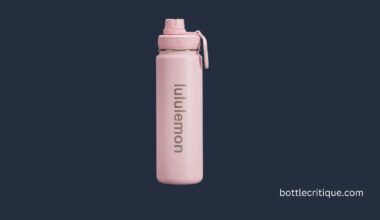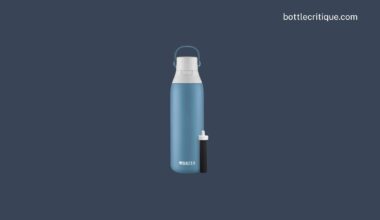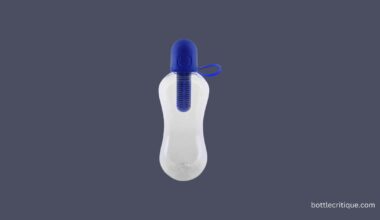Are you struggling with an algae problem in your 5-gallon water bottle? You’re not alone. Algae can be alog your dispenser, preventing the smooth flow of water.
Ready to reclaim your water bottle from the clutches of algae? Let’s get started!
Why Removing Algae from Your Water Bottle is Important
Ever stopped to wonder why it’s important to remove algae from your 5-gallon water bottle? It’s not just about keeping the water clean and clear—it goes way beyond that!
Health Risks: First and foremost, algae present certain health risks. Although most types of algae are harmless, some can produce toxins that are harmful to both humans and pets if ingested.
“Keeping your water bottle free from algae helps to ensure the safety of your drinking water and protect your health.”
Unpleasant Taste and Smell: Algae can also affect the taste and smell of your water. Even if the algae in your bottle aren’t harmful, they can still make your water taste and smell unpleasant.
Aesthetic Reasons: Lastly, let’s not forget the aesthetics! Algae can leave a green or brown residue in your bottle, which is not a pretty sight. Keeping your bottle clean enhances its appearance and makes your drinking experience more enjoyable.
Quick Summary
- Algae can pose health risks as some types produce harmful toxins.
- They can affect the taste and smell of your water.
- Algae residue is visually unpleasant, affecting the aesthetics of your water bottle.
In a nutshell, the removal of algae from your water bottle is key to maintaining good health, ensuring the quality of your water, and keeping your bottle looking fresh and clean. It’s a small task with big benefits. So why wouldn’t you want to keep your water bottle algae-free?
Where Does Algae Come From in a Water Bottle?
Ever wondered where that unsightly green blotch in your 5-gallon water bottle comes from? That’s algae! But how does it end up in your water bottle? Let’s dive into it.
Algae, a diverse group of aquatic organisms, have a knack for finding their way into water containers. Here’s how:
- Residual Algae Spores: Algae spores are ubiquitous and can hitch a ride into your water bottle through the air, on your hands, or from the sink where you clean the bottle.
- Contaminated Water: If the water you’re using to fill the bottle is contaminated with algae, your bottle can be an unwelcome host.
- Light and Warmth: Algae thrive in sunlight and warm conditions. If your water bottle frequently sits in a warm, sunny spot, it provides ideal conditions for algae growth.
Now that you know how algae sneaks into your water bottle, how about taking a look at how to rid your bottle of these unwanted guests?
Stay tuned!
How to Identify Algae in Your Water Bottle
First things first, how can you be sure that the greenish buildup in your water bottle is algae? There are a few telltale signs to look out for.
Color and Texture
Algae typically present as a green, black, or even red substance that adheres to the sides of your bottle. It may appear slimy or gritty to the touch.
Location
Unlike other types of buildup, algae like to grow in areas exposed to light. So, if you see a buildup that’s predominantly near the top of your water bottle or around the sides but not the bottom, it’s a good bet you’re dealing with algae.
Odor
Algae can also produce a distinct odor. If your water bottle smells earthy or musty, you may be dealing with an algae problem.
After you’ve identified the problem, the next step is to remove it. But how?
The Risks of Drinking Water Contaminated with Algae
Just imagine taking a refreshing gulp of your water, only to realize it has a strange taste or an unusual greenish tint. Not pleasant, right? That’s likely algae contamination in your water, and it’s more than just an aesthetic issue. It poses serious health risks that should not be overlooked.
The Health Hazards
Algae-contaminated water can lead to a variety of health issues, including:
- Gastrointestinal problems: Consuming water with high levels of algae can cause diarrhea, vomiting, and stomach cramps.
- Liver damage: Some types of algae produce toxins that can damage the liver over time.
- Neurological effects: Certain algal toxins can lead to neurological issues, such as memory loss, tremors, or seizures.
The Environmental Risks
Algae in your water isn’t just a hazard to your health. It can also pose serious risks to the environment. For instance:
- Adversely affects aquatic life: Large algal blooms can deplete oxygen in the water, leading to the death of fish and other aquatic organisms.
- Disrupts the ecosystem: Algae can outcompete other species for nutrients, disrupting the balance of the ecosystem.
So, is it worth taking these risks? Certainly not! The next step is learning how to properly clean your 5-gallon water bottle. In the upcoming sections, we’ll guide you on how to remove these unwanted algae and ensure your water stays clean, clear, and safe.
How to Clean Your 5 Gallon Water Bottle to Remove Algae
Algae can be a nuisance, but getting rid of it from your 5-gallon water bottle is a straightforward process. It’s essential to address this issue promptly to ensure the cleanliness of your water source. So, how do you go about it? Let’s find out!
1. Empty the Water Bottle
Start by emptying the water bottle completely. This is crucial as it will allow you easy access to all areas within the bottle where algae may grow.
2. Prepare a Cleaning Solution
Next, create a mixture of warm water and mild dish soap in a bowl. This mixture will act as your cleaning solution. Alternatively, you can use a mixture of one part vinegar and one part water.
3. Apply the Cleaning Solution
Pour the cleaning solution into your 5-gallon water bottle. Ensure the solution reaches all areas inside the bottle, especially where you notice the algae.
4. Scrub the Interior
With a long-handled scrubbing brush, thoroughly scrub the interior of the bottle. Pay special attention to areas where you’ve seen the algae. It’s critical to remove all traces of the algae to prevent it from regrowing.
5. Rinse Thoroughly
After scrubbing, rinse the bottle thoroughly with clean water. Make sure there is no soap residue or pieces of algae left inside.
6. Dry the Bottle
Lastly, let the bottle air dry upside down to ensure that all water is drained out. Once the bottle is completely dry, it’s ready to be refilled with clean water.
Keeping your 5-gallon water bottle algae-free is as simple as following these steps. Remember, prevention is always better than cure, so make it a habit to clean your water bottle regularly. This will save you the hassle of dealing with an algae problem in the first place. Isn’t that worth the effort?
Using Natural Methods to Remove Algae from Your Water Bottle
Algae accumulation in your 5-gallon water bottle is not just unsightly; it can also pose health risks. Fortunately, you can wage a successful war against this green invader using simple, natural methods. Ready to regain control of your water bottle? Let’s dive right in!
Natural Cleaning Agents
There are several natural substances that you can use to clean your water bottle. They are effective, safe, and likely already in your home.
- Vinegar: This kitchen staple is a great natural cleaning agent due to its acidity.
- Baking soda: This multi-purpose substance not only cleans but also deodorizes, leaving your bottle fresh and clean.
- Lemon juice: The citric acid in lemon juice makes it a powerful, natural anti-algae agent.
Step-by-step Cleaning Process
- Empty the bottle: Start by emptying your water bottle. This gives you a clear view of the algae build-up.
- Prepare a cleaning solution: Choose one of the natural cleaning agents listed above and mix it with warm water. For vinegar and lemon juice, use a 1:1 ratio with water. For baking soda, use two tablespoons for every gallon of water.
- Fill the bottle: Fill your bottle with the cleaning solution, ensuring it reaches every part of the bottle.
- Soak: Let the bottle soak for at least two hours. For stubborn algae, you might want to let it soak overnight.
- Rinse thoroughly: After soaking, rinse your bottle thoroughly with clean, warm water. Make sure all the cleaning agent is completely rinsed out.
Remember, the key to maintaining a clean water bottle is regular cleaning. Don’t wait for algae to build up. A clean bottle not only looks good but also ensures that your water remains uncontaminated and safe to drink.
Note: While these methods are generally safe, always do a spot-test with any new cleaning agent on a small, hidden part of the bottle to ensure it doesn’t damage or discolor the material.
The Best Products for Removing Algae from Your Water Bottle
Algae growth in your 5-gallon water bottle can be a nuisance. But don’t worry, there’s a variety of products available that make removing algae a breeze. Here are some of the best ones:
1. Bottle Cleaning Brushes
These special brushes are designed to reach the corners and crevices of your water bottle. They’re very effective in scrubbing away algae growth. Some even come with sponge tips for extra cleaning power.
2. Vinegar
Plain old vinegar is a natural, cost-effective solution. It’s mild acidic nature helps to break down algae, making it easy to rinse away. Ideal for regular use.
3. Baking Soda
Baking soda is another fantastic, eco-friendly cleaning agent. Paired with a bottle brush, it can effectively remove algae and eliminate odors.
4. Algae Remover Solutions
There are specific algae removal products available in stores. They’re potent, fast-acting, but should be used carefully following the manufacturer’s instructions.
5. Baby Bottle Sterilizers
A baby bottle sterilizer can also be an effective method for cleaning a water bottle. It uses heat to kill algae and other bacteria, ensuring your bottle is entirely clean and safe.
Remember, no one product is the best for everyone. It all depends on your specific needs and preferences. So, which one will you choose to remove algae from your 5-gallon water bottle?
How Often Should You Clean Your 5 Gallon Water Bottle?
How often should you clean your 5 gallon water bottle? Well, the frequency of cleaning depends largely on its usage. However, as a rule of thumb, it’s a good idea to clean it every time it gets emptied, or at least once a week.
Regular maintenance ensures that your water stays fresh and doesn’t develop a stale taste. It also prevents the buildup of algae, bacteria, and other microorganisms that can potentially harm your health.
Factors Affecting Cleaning Frequency
- Usage: If you’re using the bottle frequently, it’s best to clean it more often.
- Storage: When stored in a cool, dry place, the growth of algae and bacteria slows down, reducing the necessity of cleaning.
- Water Quality: If the water you’re adding to the bottle is treated and clean, you might not need to clean as often. Conversely, untreated and hard water may require more frequent cleaning.
Remember, the goal is to keep your water bottle as clean and hygienic as possible. Maintaining a regular cleaning schedule helps achieve this goal and contributes to better health.
Cleaning a 5 gallon water bottle might seem like a chore, but it’s a small price to pay for the assurance of safe, clean water. And once you get into the rhythm of it, you’ll find it’s not that difficult at all!
Tips for Preventing Algae Growth in Your Water Bottle
Even though we have discussed how to remove algae from your water bottle, prevention is always the best solution. Let’s talk about some simple steps you can take to avoid the growth of algae in the first place.
Keep it Clean
Regular cleaning is key to preventing algae growth. Rinse your water bottle out after each use and give it a thorough cleaning at least once a week. This keeps algae from gaining a foothold.
Store it Dry
Algae thrive in damp environments. After cleaning your bottle, make sure it’s completely dry before you store it. A bottle left damp is an open invitation for algae to start growing.
Use Light Wisely
Algae also need light to grow. Don’t leave your water bottle in direct sunlight for long periods. Instead, store it in a cool, dark place when not in use.
Avoid Storing Water for Too Long
Storing water for extended periods can encourage algae growth. If you’ve filled your bottle but haven’t used all the water within a day or two, it’s best to empty it out and refill when needed.
Consider Using Algae Inhibitors
If you have persistent issues with algae, you might want to consider using an algae inhibitor. These are commonly used in fish tanks and can be effective in water bottles too. Just be sure to choose a non-toxic, food-safe option.
Remember, a clean water bottle is not just about preventing algae. It’s also about maintaining your health. Don’t give algae or any other germs a chance to ruin your day!
Alternative Water Storage Options to Consider
Ever thought of an alternative to the 5-gallon water bottle? Yes, there are numerous options available that can provide clean, algae-free water storage. Let’s take a look:
Stainless Steel Water Containers
Stainless steel water containers are an excellent choice for water storage. These containers are not only durable but also resistant to the growth of algae, thanks to their opaque nature. They come in various sizes and shapes, making them a versatile option for different needs.
Glass Water Bottles
Another viable alternative is glass water bottles. They are easy to clean and prevent the growth of algae due to their non-porous nature. However, they require careful handling since they are prone to breakage.
Water Cooler Dispensers
Water cooler dispensers are also a great consideration. They provide a convenient way of storing and dispensing water, plus, they are easy to clean, reducing the chance of algae growth.
Water Storage Bladders & Tanks
If you need to store larger quantities of water, water storage bladders and tanks can be a great solution. They are designed to resist algae growth and can cater to both small and large water storage requirements.
Remember, no matter the storage option, maintenance and cleanliness are key to keeping algae at bay. So, which alternative will you consider?
Conclusion: Keeping Your Water Safe and Algae-Free
In conclusion, keeping your 5-gallon water bottle free from algae is not just about aesthetics, it’s about your health too. Algae can taint the taste and smell of your drinking water, possibly even causing health issues if consumed in large amounts. But with a little vigilance and regular cleaning, you can easily prevent their growth and ensure that your drinking water remains fresh and clean.
Here’s a quick recap of the key steps:
- Regular Cleaning: Don’t wait until you see green in your bottle. It’s best to clean your water bottle at least once a week with a mild bleach solution.
- Proper Drying: After cleaning, make sure to dry your bottle completely. Moisture is the prime breeding ground for algae, so don’t let it linger longer than necessary.
- Storage: Store your bottle in a cool, dry place and avoid direct sunlight as much as possible. Excessive heat and light can stimulate algae growth.
Remember, prevention is always better than cure. The time and effort you invest in cleaning your water bottle regularly will pay off in the long run, ensuring your water remains safe to drink and free from any unwanted taste or odor.
To make the process easier and more efficient, consider investing in a good bottle brush and a drying rack. They can help you clean those hard-to-reach areas and speed up the drying process. And remember, if you’re in doubt about the cleanliness of your water, boil it before drinking or use a water purifier.
So, are you ready to keep your water safe and algae-free?






